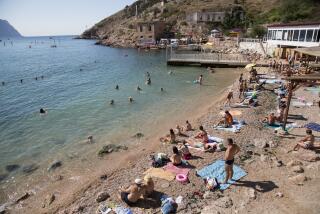Curbs on Tourism Ease in Crimea
- Share via
KIEV, Ukraine — The city of Sevastopol--longtime playground of the Russian aristocracy--has eliminated special permit requirements for tourists, thus opening doors that have been closed to travelers since the early 1920s.
Perched on the tip of the sun-drenched Crimea Peninsula and overlooking the Black Sea, Sevastopol is a key port in a region that has been ruled by Greeks and Tatars, was annexed by Catherine the Great during the bloody Crimean War (1854-56), and is the site of the vacation dachas of many Soviet officials.
It’s an area rich in history, but only intrepid travelers need apply. The State Department warns that the region is politically unstable, medical care limited, internal travel difficult and the risk of crime high. However, once there, military buffs can visit nearly 1,000 historical monuments and landmarks devoted to battles for the city during the Crimean War and World War II.
For antiquities enthusiasts, Sevastopol boasts Greek ruins of a former city-state called Chersonesus Taurica.
After 70 years as a Soviet museum, the Inkerman Cave Monastery (pictured left), north of the city, has been returned to the Ukrainian Orthodox Church. Monks give tours of four cave churches carved out of the sandstone cliffs, and remains of the 15th century Kalamita Fortress can be seen on the plateau above.
Tourist facilities are basic. Hotels are inexpensive, but travelers get what they pay for. Decor at the top-of-the-line Hotel Ukraina is proletarian brown but reasonably clean. Cold water runs all day, but is shut off at night, and this summer hot water was limited to Sundays and Wednesdays 6-9 a.m. and 6-9 p.m.
Although permits are no longer required for Sevastopol, tourists must have a visa to enter Ukraine. In the United States, individual and group tours can be arranged through: Scope Travel, 1605 Springfield Ave., Maplewood, NJ 07040; tel: (800) 242-7267.
More to Read
Sign up for The Wild
We’ll help you find the best places to hike, bike and run, as well as the perfect silent spots for meditation and yoga.
You may occasionally receive promotional content from the Los Angeles Times.






